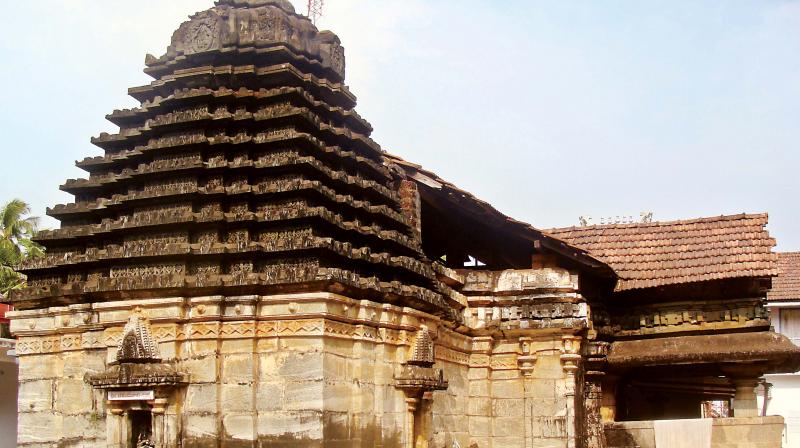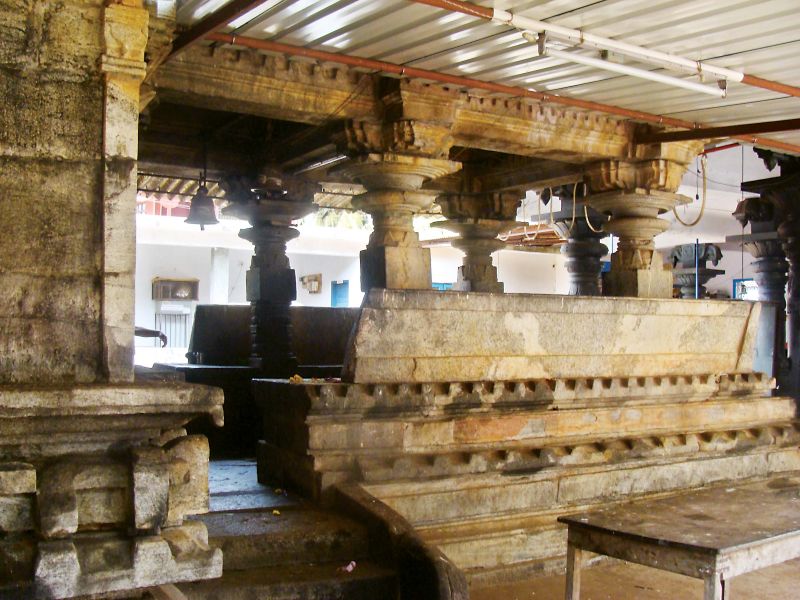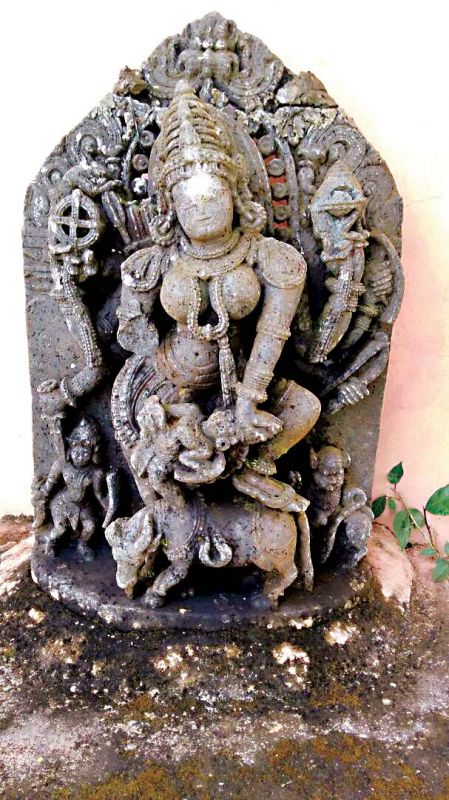Sunday story: Wrecking abode of the Gods! Not ISIS, but homegrown renovationists

Subrahmanya Bhat, a devotee, has visited this temple of Sri Shankarnarayana in the foothills of the Western Ghats for as long as he can remember, savouring the feel beneath his feet of the well-worn stone steps that lead up to the sanctum sanctorum, the images and the play of light from the age-old lamps on the lingam that he has prayed to, for more years than he can remember.
 (Below) Sheets block the carvings after renovation of the temple. Old stones have been replaced by modern tiles on the floor
(Below) Sheets block the carvings after renovation of the temple. Old stones have been replaced by modern tiles on the floor
But as he walked into the temple a few weeks ago, Bhat was thrown. The newly renovated temple bore little resemblance to the temple that he used to pray in!
A new idol had been installed in the 'garba griha!' The old carvings of the temples dating back to Vijayanagara era were dumped outside, neglected! Bhat, disoriented and lost had just one thought - why did it have to be renovated in the first place, severing the link between him and his God!
 The idol of Kali (Durgaparameshwari) at Kolli which was removed from ‘garba griha’ and installed in another small room.
The idol of Kali (Durgaparameshwari) at Kolli which was removed from ‘garba griha’ and installed in another small room.
 The idol of Mahishamardhini, which was removed from a temple in Kundapur
The idol of Mahishamardhini, which was removed from a temple in Kundapur
Bhat's experience isn't an isolated one. Hundreds of temples in the coastal districts that withstood foreign armies, intolerant kings and the ravages of time stand helpless in the face of modern day administrators, who have little or no inkling of the historic value of these structures, and refashion these to match modern times. Many of the hallowed idols of deities, which served as an invaluable link with the historic art and architecture of the region, are now disappearing fast with even the idols being replaced to make way for the new.
In the name of renovation, many temples have lost their traditional idols, which are replaced even if they are slightly damaged, on the advice of astrologers or the local Tantri. Some undergo ritual immersion in water and disposed. As at the Mahishamardhini Temple at Bagvadi in Kundapur, which has undergone an equally shocking transformation. Others are simply dumped.
“The temple had a very beautiful Mahishamardhini idol, one of the oldest of the region dating back to the 9th century. It was an example of the 'Kushana style' of architecture. But a few years ago, the temple authorities removed it and replaced it with a new idol. The old one was disposed in the water,” laments Prof T. Murugeshi of MSRS College.
“In the last three decades, many temples have undergone such 'renovation' with the history of the place completely lost. Every idol and every architectural style is a link to history and has something to say about the past. It is sad that they are unnecessarily destroyed. The saddest part is that the old idols are not preserved, instead they are immersed in water," says Prof. Murugeshi.
“Many stone temples have been replaced by concrete structures now,” he added.
Said another historian: “The renovated temples have lost their historical touch. The centuries old carvings and the art works (most are typical of Vijayanagara or Keladi era) have been replaced by modern work. The handmade carvings are now replaced by machine-made carvings. Though there is some similarity, the change is clearly visible. Massive Rajagopurams which is not typical style of the coastal belt too have now started appearing in some temples.”
Historians and temple committees are clearly at odds over the renovation, with temple committees saying they want to renovate the temple in a grand manner. Except, in the process, nothing remains of the original shrine and the traditions associated with it.
Joining the historians are religious scholars who have expressed their unhappiness over the new fad. "In recent years, idols are replaced even if there is a small crack. But as per tradition, an idol worshipped as God in a temple is replaced only if an important part of it is damaged or broken. If parts of the idol like the fingers, ears, hands, legs are damaged, they can be retained by repairing and setting right the damage. There is a ritual to repair or replace such organs, which only a few are aware of,” explains Sanskrit scholar and Astavadhani Subrahmanya Bhat Gundibail. “Sri Gurunarasimha Swamy idol at Saligrama which was damaged, has been set right as per rituals a few years ago. Some temple committees agree to repair the old idols but many change them, which is not right. I try my best to stop such destruction of idols. In the last one year, I have repaired two idols as per rituals. In places where temple authorities are bent on changing the idols, I along with my friend take away these idols and pr
eserve them. We cannot afford to lose our history," adds Gundibail.
Clearly, the new idols do not have the beauty of the old. “Most of the idols in the region were made of black stone called ‘Nellikar Shile,’ available at Nellikar in Dakshina Kannada. They are black in colour and smooth to carve. But this stone is not available now. The ones which are available in nearby villages, are not the same colour as the Nellikar stone,” he explains. In some temples in Udupi and DK district where the old idols were removed and new ones installed, the reverse has also happened - through 'Prashna,' (astrology) the astrologers came to the conclusion that the old idol still had divine powers and had them re-installed at another place in the temple. The ‘Kali,’ Sri Durgaparameshwari image at Kolli Sri Durga Devi Temple is one such idol which was to be immersed in water after it was taken out of the sanctum sanctorium. It is now worshipped in a small room on the temple premises as per the advice of astrologers.
Temples are places where people go for answers to still the doubts in troubled minds. Their walls may be crumbling and their oil lamps their rough edges but it’s amidst these flickering lights that many seek to reinvigorate ourselves with hope - not inside the four walls of lifeless concrete structures, which are fast replacing our ancient shrines.

